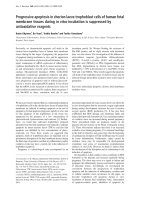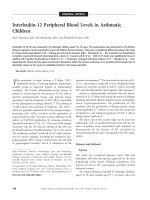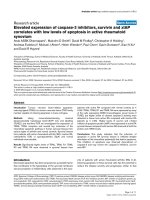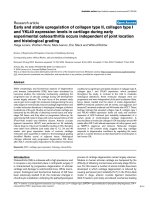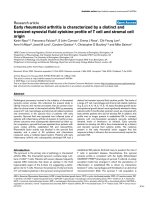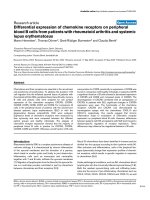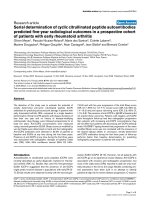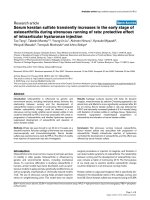Bóa cáo y học: " Early apoptosis of blood monocytes in the septic host: is it a mechanism of protection in the event of septic shock" ppt
Bạn đang xem bản rút gọn của tài liệu. Xem và tải ngay bản đầy đủ của tài liệu tại đây (379.16 KB, 8 trang )
Open Access
Available online />Page 1 of 8
(page number not for citation purposes)
Vol 10 No 3
Research
Early apoptosis of blood monocytes in the septic host: is it a
mechanism of protection in the event of septic shock?
Evangelos J Giamarellos-Bourboulis
1
, Christina Routsi
2
, Diamantis Plachouras
1
, Vassiliki Markaki
2
,
Maria Raftogiannis
1
, Dimitrios Zervakis
2
, Vassilios Koussoulas
1
, Stylianos Orfanos
3
,
Anastasia Kotanidou
2
, Apostolos Armaganidis
3
, Charis Roussos
2
and Helen Giamarellou
1
1
4th Department of Internal Medicine, University of Athens, Medical School, Greece
2
1st Department of Critical Care, University of Athens, Medical School, Greece
3
2nd Department of Critical Care, University of Athens, Medical School, Greece
Corresponding author: Evangelos J Giamarellos-Bourboulis,
Received: 2 Feb 2006 Revisions requested: 22 Feb 2006 Revisions received: 28 Mar 2006 Accepted: 18 Apr 2006 Published: 12 May 2006
Critical Care 2006, 10:R76 (doi:10.1186/cc4921)
This article is online at: />© 2006 Giamarellos-Bourboulis et al.; licensee BioMed Central Ltd.
This is an open access article distributed under the terms of the Creative Commons Attribution License ( />),
which permits unrestricted use, distribution, and reproduction in any medium, provided the original work is properly cited.
Abstract
Introduction Based on the central role of the triggering of
monocytes for the initiation of the septic cascade, it was
investigated whether apoptosis of blood monocytes in septic
patients is connected to their final outcome.
Methods Blood monocytes were isolated from 90 patients with
septic syndrome due to ventilator-associated pneumonia on
days 1, 3, 5 and 7 from the initiation of symptoms. Apoptosis
was defined after incubation with annexin-V-fluorescein
isothiocyanate and propidium iodine and reading by a flow
cytometer. The function of first-day monocytes was evaluated
from the concentrations of tumour necrosis factor alpha (TNFα)
and IL-6 in supernatants of cell cultures after triggering with
endotoxins. TNFα, IL-6 and IL-8 were estimated in serum by an
enzyme immunoassay.
Results Mortality rates of patients with apoptosis ≤50%
compared with patients with apoptosis >50% were 49.12%
and 15.15%, respectively (P < 0.0001). Kaplan-Meier analysis
showed a 28-day survival benefit in patients with septic shock
and monocyte apoptosis >50% compared with those patients
with apoptosis ≤50% (P = 0.0032). Production of IL-6 by
monocytes on the first day by patients with apoptosis ≤50% was
similar compared with monocytes isolated from healthy controls.
Serum concentrations of TNFα were higher in patients with
monocyte apoptosis ≤50% and septic shock compared with
patients with apoptosis >50% on day 7; similar findings
occurred for serum IL-6 on days 1 and 7 and for serum IL-8 on
days 1 and 5.
Conclusion Early apoptosis of monocytes upon presentation of
clinical signs of sepsis is connected to a favourable outcome.
These findings are of particular importance for the patient with
septic shock, where they might constitute a mechanism of
pathogenesis.
Introduction
Apoptotic cascade is a process already described to super-
vene during the evolution of sepsis in lymphocytes, in tissue
macrophages and in intestinal epithelia, and it is connected to
organ dysfunction [1]. Although data for the apoptosis of cells
of the adaptive immune system are available, little evidence
exists for the implication of the innate immune system [2]. The
need for knowledge in that field is further aggravated by the
central role of monocytes in the pathogenesis of sepsis [3].
The existing theory for the pathogenesis of sepsis is based on
the overproduction of proinflammatory cytokines by blood
monocytes when triggered by the cell-wall constituents of the
bacterial pathogens [4]. The present study aimed to clarify that
field with special focus on septic shock. Attention to septic
shock was based on the immune imbalance diagnosed early
before advent of shock and expressed by a considerable
increase of proinflammatory mediators [5].
The main characteristic of the present study was that the entire
population enrolled became septic because of the same
IL = interleukin; LPS = lipopolysaccharide; PBS = phosphate-buffered saline; pO
2
/FiO
2
= partial oxygen pressure/fraction of inspired oxygen; TBS=
tracheobronchial secretions; TNFα = tumour necrosis factor alpha; VAP = ventilator-associated pneumonia.
Critical Care Vol 10 No 3 Giamarellos-Bourboulis et al.
Page 2 of 8
(page number not for citation purposes)
underlying infection – ventilator-associated pneumonia (VAP).
This is a striking difference compared with all other clinical tri-
als on sepsis, and it was based on the need to elaborate an
entire study population conferring an antigenic stimulus that
did not differ considerably within patients. The enrolment of
patients with different types of antigenic stimuli has been impli-
cated as a great disadvantage in the evaluation of clinical trials
on sepsis [6].
Patients and methods
Study design
A total of 90 patients were enrolled in a prospective study con-
ducted over the period June 2004 to January 2005. Patients
were hospitalized in the Department of Critical Care of the
'Evangelismos' General Hospital and in the 2
nd
Department of
Critical Care of the 'ATTIKON' University Hospital of Athens.
The study was approved by the Ethics Committee of both hos-
pitals. All enrolled patients were intubated for at least 48 hours
prior to enrolment and they were aged older than 18 years.
Written informed consent was provided by their first-degree or
second-degree relatives in accordance with the Helsinki dec-
laration of 1975. Exclusion criteria were the presence of neu-
tropaenia (<500 neutrophils/mm
3
), HIV infection, and the oral
intake of corticosteroids at a dose equal to or higher than 1
mg/kg equivalent prednisone for a period longer than one
month.
Inclusion criteria were the concomitant presence of VAP and
of sepsis, severe sepsis or septic shock. None of the enrolled
patients was suffering from solid tumour malignancy.
Table 1
Clinical characteristics of patients with ventilator-associated pneumonia enrolled in the study categorized according to the ACCP/
SCCM classification.
Characteristic Sepsis Severe sepsis Septic shock
Number of patients 27 27 36
Age (years, mean ± SD) 52.6 ± 20.8 67.7 ± 13.6 58.0 ± 18.1
Male/female 20/7 18/9 27/9
APACHE II score (mean ± SD) 15.63 ± 6.06 17.88 ± 4.19 19.40 ± 7.03*
Sequential Organ Failure Assessment score (mean ± SD) 5.78 ± 2.82 7.21 ± 2.83 9.54 ± 4.10
†
White blood cells (/μl, mean ± SD) 12.132,6 ± 5.060,7 13.850,0 ± 7.026,9 14.206,0 ± 8.683,0
Underlying conditions [n (%)]
Multiple trauma 8 (29.62) 1 (3.70) 9 (25.00)
Brain haemorrhage 6 (22.22) 7 (25.92) 3 (8.33)
Respiratory failure due to chronic obstructive
pulmonary diseases
8 (29.62) 8 (29.62) 11 (30.55)
Acute abdomen 1 (3.70) 2 (7.41) 4 (11.11)
Celiac aorta aneurysm replacement - 2 (7.41) 3 (8.33)
Others 4 (14.81) 7 (25.92) 6 (16.66)
Predisposing factors [n (%)]
Diabetes mellitus type 2 4 (14.81) 4 (14.81) 6 (16.66)
Coronary heart disease 3 (11.11) 8 (29.62) 4 (11.11)
Hypertension 2 (7.41) 6 (22.22) 4 (11.11)
Others 6 (22.22) - 8 (22.22)
Pathogens [n (%)]
Acinetobacter baumannii 10 (37.03) 11 (40.74) 16 (44.44)
Pseudomonas aeruginosa 5 (18.51) 7 (25.92) 4 (11.11)
Others 2 (7.41) 3 (11.11) 2 (5.55)
Bacteraemia [n (%)] 4 (14.81) 3 (11.11) 5 (13.88)
Case fatality [n (%)] 6 (22.2) 9 (33.3) 18 (50.0)
APACHE, Acute Physiology and Chronic Health Evaluation; SD, standard deviation. *P = 0.017 compared with patients with sepsis.
†
P =
<0.0001 compared with patients with sepsis and P = 0.011 compared with patients with severe sepsis.
Available online />Page 3 of 8
(page number not for citation purposes)
Diagnosis of sepsis was based on the presence of at least two
of the following [12]: core temperature >38°C or <36°C,
P
CO
2
partial pressure of carbon dioxide <32 mmHg, pulse
rate >90/minute, and white blood cells >12,000/μl or
<4,000/μl or >10% of bands.
Diagnosis of VAP was established in any patient presenting
with the following signs: core temperature >38°C or <36°C,
new or persistent consolidation in a lung X-ray, and purulent
trancheobronchial secretions (TBS) [7-11].
Severe sepsis was determined as the acute dysfunction of at
least one organ. This was evaluated by the acute presentation
of at least one of four criteria [12]: acute respiratory distress
syndrome, any value of pO
2
/FiO
2
below 200 with the pres-
ence of diffuse shadows in a lung X-ray; acute renal failure, the
production of less than 0.5 ml urine/kg body weight/hour for at
least 2 hours provided that the negative fluid balance of the
patient was corrected; metabolic acidosis, any pH < 7.30 or
any base deficit > 5 mEq/l and serum lactate at least more
than twice the normal value; and acute coagulopathy, any
platelet count <100,000/μl or International Normalized Ratio
> 1.5
Septic shock was considered any value of systolic pressure
<90 mmHg requiring the administration of vasopressors [12].
Sedation was achieved in all patients with the intravenous
administration of midazolame and propofol 1%. Upon enrol-
ment in the study, quantitative TBS cultures were performed.
TBS were collected after insertion of a sterile catheter in the
intubation tube or in the tracheostomy connected to a negative
pressure device. Enrolled patients were followed up on a daily
basis for a total of 28 days; evaluation comprised lung X-rays,
estimation of the pO
2
/FiO
2
ratio and of the Acute Physiology
and Chronic Health Evaluation II and Sequential Organ Failure
Assessment scores. Resolution of VAP was considered as any
decrease of X-ray findings accompanied by an increase of the
pO
2
/FiO
2
ratio. Antimicrobial therapy of VAP was selected by
attending physicians according to published guidelines [8,9].
Laboratory examinations were performed for seven consecu-
tive days with sampling of 10 ml blood after venipuncure of a
peripheral vein under sterile conditions. Isolation of blood
monocytes was performed on each second day. Five millilitres
of blood were added into commercially available flasks for cul-
ture (Becton Dickinson, Cockeysville MD, USA); 3 ml were
then collected in a heparinized syringe for isolation of mono-
cytes and 2 ml were collected in a sterile tube. After centrifu-
gation, the serum was kept at -70°C for the estimation of the
concentrations of tumour necrosis factor alpha (TNFα), of IL-6
and of IL-8.
Table 2
Concentrations of tumour necrosis factor-alpha (TNFα), interleukin(IL)-6 and IL-8 in relation to monocyte apoptosis (≤50% or >50%)
of the first day
Day Sepsis Severe sepsis Septic shock
≤50% (n = 20) >50% (n = 7) ≤50% (n = 18) >50% (n = 9) ≤50% (n = 19) >50% (n = 17)
Tumour necrosis factor alpha
1 4.97 ± 1.91 4.95 ± 0.20 6.84 ± 0.97 7.33 ± 28.20 6.98 ± 11.21 6.85 ± 3.29
3 7.28 ± 4.39 5.23 ± 19.50 5.70 ± 37.30 5.16 ± 1.48 5.15 ± 14.45 9.98 ± 1.74
5 5.33 ± 0.86 5.08 ± 5.03 6.37 ± 10.92 7.39 ± 2.26 10.32 ± 30.03 9.36 ± 7.52
7 6.22 ± 4.37 6.58 ± 0.63 4.83 ± 3.23 5.92 ± 2.22 12.44 ± 18.41 6.12 ± 3.20*
IL-6
1 95.4 ± 24.2 123.1 ± 61.1 102.9 ± 20.3 69.4 ± 26.4 212.3 ± 30.7 88.3 ± 25.3*
3 80.1 ± 21.2 63.7 ± 27.7 96.6 ± 26.1 114.6 ± 31.8 141.2 ± 25.7 83.2 ± 22.1
5 89.4 ± 25.4 112.2 ± 50.1 96.5 ± 23.1 98.7 ± 38.3 128.2 ± 36.0 76.5 ± 23.4
7 61.3 ± 21.3 41.4 ± 49.5 107.2 ± 24.7 99.9 ± 27.9 160.4 ± 30.2 57.4 ± 23.6*
IL-8
1 181.5 ± 152.9 403.6 ± 315.1 62.5 ± 33.3 62.5 ± 143.2 255.4 ± 126.5 62.5 ± 72.7*
3 152.4 ± 145.2 62.5 ± 91.2 62.5 ± 31.8 62.5 ± 230.9 95.3 ± 140.8 62.5 ± 119.7
5 62.5 ± 54.7 423.5 ± 103.2 62.5 ± 70.0 314.6 ± 210.2 623.8 ± 206.6 62.5 ± 123.5*
7 99.9 ± 114.4 62.5 ± 80.9 62.5 ± 88.9 108.1 ± 281.6 128.1 ± 281.6 355.2 ± 94.4
Data presented as the median ± standard error (pg/ml). *P < 0.05 compared with patients of the same group with apoptosis ≤50%.
Critical Care Vol 10 No 3 Giamarellos-Bourboulis et al.
Page 4 of 8
(page number not for citation purposes)
Laboratory techniques
Quantitative TBS cultures were performed after collection.
TBS (0.5 ml) was added to a sterile tube with 2 ml dithiothre-
itol (1 mg/ml; Oxoid Ltd, London, UK) and diluted five consec-
utive times in the ratio 1:10. Volumes of 0.1 ml each dilution
were plated onto McConkey, blood and Saboureaud agar
(Becton Dickinson). Dishes were incubated for 5 days at 37°C
or 42°C for Saboureaud plates and their count was estimated
after multiplying with the appropriate dilution factor. Cultures
yielding a pathogen at a count ≥1 × 10
6
colony-forming units/
ml were considered positive [13]. Flasks with blood were incu-
bated for 7 days. Identification of pathogens was performed by
the API20E and the API20NE systems (bioMérieux, Paris,
France).
For the isolation of blood monocytes, the collected
heparinized venous blood was layered over Ficoll Hypaque
(Biochrom, Berlin, Germany) and centrifuged. Isolated mono-
nuclear cells were washed three time with PBS (pH 7.2)
(Merck, Darmstadt, Germany) and incubated with RPMI 1640
enriched with 10% foetal bovine serum and 2 mM glutamine
in the presence of 100 U/ml penicillin G and 0.1 mg/ml strep-
tomycin (Sigma Co, St Louis, MO, USA) in 25 cm
3
flasks. After
1 hour of incubation at 37°C in 5% CO
2
, nonadherent cells
were removed; adherent monocytes were thoroughly washed
with Hanks' solution (Biochrom). Monocytes were then
harvested with a 0.25% thrypsin/0.02% ethylenediamine
tetraacetic acid solution (Biochrom) and counted in a Neu-
bauer plate. Their purity was more than 95%, determined after
staining with the anti-CD14 monoclonal antibody at the fluor-
ocolour fluorescein isothiocyanate (emission 520 nm; Immu-
notech, Marseille, France) and reading through the EPICS XL/
MSL flow cytometer (Beckman Coulter Co, Miami, FL, USA).
Their viability was assessed by trypan blue.
For the estimation of monocyte apoptosis, cells were incu-
bated for 15 minutes in the dark with the protein annexin-V at
the flurocolour fluorescein isothiocyanate (emission 520 nm;
Immunotech) and with propidium iodine at the fluorocolour
EC5 (emission 550 nm; Immunotech). Annexin-V is connected
to the phospatidylserine residue revealed in cell membranes
upon initiation of the apoptotic process. Propidium iodine is
connected to dead cells. Monocytes staining positive for
annexin-V and staining negative for propidium iodine after run-
ning through the EPICS XL/MSL flow cytometer (Beckman
Coulter Co.) were considered apoptotic (Figure 1). Apoptosis
of monocytes was estimated for four healthy volunteers iso-
lated as described earlier.
Figure 1
Monocytes apoptosis of two septic patients after flow cytometric analysis; ANNEXIN-V(+)PI(-) cells (region H4) are considered apoptoticMonocytes apoptosis of two septic patients after flow cytometric analysis; ANNEXIN-V(+)PI(-) cells (region H4) are considered apoptotic.
Figure 2
Apoptosis of monocytes of 36 patients with septic shock in relation to final outcome. Circles denote outliers and asterisks extremesApoptosis of monocytes of 36 patients with septic shock in relation to
final outcome. Circles denote outliers and asterisks extremes.
Available online />Page 5 of 8
(page number not for citation purposes)
The function of monocytes was determined only for cells iso-
lated on the first day. After estimation of their apoptosis, mono-
cytes were distributed in two wells of a 12-well plate; they
were incubated with RPMI 1640 supplemented with 10% foe-
tal bovine serum and 2 mM glutamine for 18 hours at 37°C in
5% CO
2
in the absence/presence of 100 ng/ml purified endo-
toxin (lipopolysaccharide (LPS)) derived from Escherichia coli
O144:H4 (Sigma Co.). After incubation, cell supernatants
were collected and kept refrigerated at -70°C until assayed for
cytokines. Each day of the experiment, four well controls were
applied with monocytes isolated from two healthy volunteers.
The concentrations of TNFα, IL-6 and IL-8 in sera were esti-
mated by an enzyme immunoabsorbent assay (Diaclone, Paris,
France). The lowest limits of detection were 0.5 pg/ml for
TNFα, 6.25 pg/ml for IL-6 and 62.5 pg/ml for IL-8. The intra-
assay and inter-assay variation coefficient of the assays were
4.6 and 5.8% for TNFα, 4.6 and 12.1% for IL-6, and 5.0 and
11.1% for IL-8. Concentrations of TNFα and of IL-6 were also
estimated in cell supernatants and expressed as pg/10
4
of live
cells. The function of monocytes was determined after sub-
tracting the concentrations of TNFα and IL-6 following incuba-
tion in the presence of LPS from the concentrations of TNFα
and IL-6 following incubation in the absence of LPS.
Statistical analysis
Results are expressed as medians ± 95% confidence intervals
or medians ± standard error. Comparisons were performed by
the Mann-Whitney U test after correction with the Bonferroni
test. All patients were divided into two groups according to
monocyte apoptosis on the first day: ≤50% and >50%. The
selection of 50% as a cutoff point was based on designing
receiver-operating characteristic curves for survival with cutoff
values of 40%, 50% and 60%. The greatest area under the
curve was generated with a cutoff value of 50%, which was
applied in the study.
Figure 3
Comparative survival of 36 patients with septic shock in relation to monocyte apoptosis of the first day (≤50% or >50%)Comparative survival of 36 patients with septic shock in relation to
monocyte apoptosis of the first day (≤50% or >50%).
Figure 4
Ex vivo production of TNF? and IL-6 by first day monocytes in relation to apoptosis, without (-) / with (+) triggering by LPS. Circles denote outliers and asterisks extremes. a: response lower than controls Ex vivo production of TNF
α and IL-6 by first day monocytes in relation
to apoptosis, without (-) / with (+) triggering by LPS. Circles denote
outliers and asterisks extremes. a: response lower than controls
Critical Care Vol 10 No 3 Giamarellos-Bourboulis et al.
Page 6 of 8
(page number not for citation purposes)
In order for apoptosis of monocytes to constitute a separate
pathophysiological mechanism in sepsis, it should probably be
correlated to survival. For that purpose, the survival of each
group was estimated by Kaplan-Meyer analysis; comparisons
were performed by the log-rank test. Statistical correlations
were assayed after assessment of the nonparametric Spear-
man coefficient (r
s
). Monocyte apoptosis between patients
who died or who eventually survived was compared by
Fischer's exact test. P < 0.05 was considered statistically
significant.
Results
Clinical characteristics of patients enrolled in the study are
presented in Table 1. Three patients were chronic abusers of
alcohol and 34 patients were chronic cigarette smokers, cor-
responding to 35.71% and 42.42% of patients with apoptosis
of monocytes ≤50% and >50% on the first day (P = not sig-
nificant). VAP was not microbiologically documented in 10
patients with sepsis, in eight patients with severe sepsis and
in 14 patients with septic shock. Kaplan-Meier estimates of
survival over 28 days of follow-up of the entire patient popula-
tion in correlation to apoptosis of monocytes on the first day
showed that patients with monocyte apoptosis on the first day
>50% survived longer than patients with monocyte apoptosis
≤50% (P = 0.049). Death supervened in 28 patients with
apoptosis ≤50% (mortality 49.12%) and in five patients with
apoptosis >50% (mortality 15.15%, P < 0.0001).
The median ± standard error monocyte apoptosis on the first
day of survivors with sepsis was 37.74 ± 5.81%, and that of
nonsurvivors was 11.71 ± 8.24% (P = not significant). The
respective values for patients with severe sepsis were 44.43
± 7.18% and 38.11 ± 9.63% (P = not significant), and those
for patients with septic shock were 55.43 ± 7.11% and 27.61
± 6.79% (P = 0.036). Apoptosis of monocytes of the four
healthy volunteers ranged between 5.0% and 9.2%. Changes
of monocyte apoptosis over time in relation to the final out-
come in patients with septic shock are shown in Figure 2.
Six patients with sepsis and monocyte apoptosis ≤50% on the
first day died (mortality 15%), but no patient with sepsis and
monocyte apoptosis >50% died (mortality 0%, P = not signif-
icant between groups). Seven patients with severe sepsis and
monocyte apoptosis ≤50% on the first day died (mortality
38.9%), while two patients with severe sepsis and monocyte
apoptosis >50% died (mortality 22.2%, P = not significant
between groups). Fifteen patients with septic shock and
monocyte apoptosis ≤50% on the first day died (mortality
78.9%), and three patients with septic shock and monocyte
apoptosis >50% died (mortality 17.64%, P = 0.0001
between groups). Kaplan-Meier estimates of survival over 28
days of follow-up in correlation to apoptosis on the first day for
36 patients with septic shock are shown in Figure 3; those
Figure 5
Comparative concentrations of IL-6 and IL-8 over follow-up of patients with septic shock in relation to monocyte apoptosis of the first day.Comparative concentrations of IL-6 and IL-8 over follow-up of patients
with septic shock in relation to monocyte apoptosis of the first day
Figure 6
ROC curves of ≥50% apoptosis of monocytes of the first day for sur-vival and for diagnosis of septic shockROC curves of ≥50% apoptosis of monocytes of the first day for sur-
vival and for diagnosis of septic shock.
Available online />Page 7 of 8
(page number not for citation purposes)
with monocyte apoptosis >50% survived longer than those
with apoptosis ≤50% (P = 0.0032 between groups).
Median apoptosis of monocytes on the first day of patients
with bacteraemia was 55.96%, and that of patients without
bacteraemia was 36.06% (P = 0.020). Moreover, bacteraemia
was found in four patients with monocyte apoptosis ≤50% on
the first day (7.02%) and in eight patients with apoptosis
>50% (24.2%, P = 0.027 between groups of apoptosis).
Production of TNFα and IL-6 of blood monocytes of patients
isolated from the entire study population on the first day of
symptoms in relation to their apoptosis are shown in Figure 4.
Positive correlation was found between production of TNFα
after triggering with LPS and monocyte apoptosis on the first
day (r
s
= +0.236, P = 0.032).
Changes of TNFα, IL-6 and IL-8 of patients' sera in relation to
monocyte apoptosis on the first day are presented in Table 2.
Positive correlation was found between monocyte apoptosis
and concentrations of TNFα on days 3 and 5 (r
s
= +0.257, P
= 0.033 and r
s
= +0.257, P = 0.044, respectively). Compara-
tive concentrations of IL-6 and IL-8 among patients with septic
shock and monocyte apoptosis <50% and ≥50% are shown
in Figure 5.
Receiver-operating characteristic curves of apoptosis of
monocytes ≤50% for the prediction of final survival are shown
in Figure 6.
Discussion
The present study investigated the existence of apoptosis in
blood monocytes over the evolution of sepsis and its correla-
tion to the final outcome of the host. The study design suc-
ceeded to eliminate, as much as possible, confounding factors
produced when septic patients with various types of infections
of probable polymicrobial origin are considered together.
Microbiological findings pointed towards a predominance of
Gram-negative bacteria as responsible pathogens and
towards a monomicrobial cause of VAP (Table 1).
It was proved that apoptosis is a phenomenon taking place in
blood monocytes upon presentation of the clinical signs of
sepsis (Figure 1). Moreover, it was shown for the first time in
the literature that the probability of survival of the septic patient
was in parallel to apoptosis on the first day. The latter finding
was particularly pronounced in the event of septic shock.
Monocyte apoptosis was significantly higher for patients with
septic shock who survived compared with those patients with
septic shock who died (Figure 2), a phenomenon accompa-
nied by greater mortality among patients with septic shock and
apoptosis ≤50% compared with patients with septic shock
and apoptosis >50% (Figure 3). In the latter subgroup of
patients, differences in apoptosis were still present on day five
of follow-up (Figure 2). Moreover, serum levels of proinflamma-
tory cytokines of patients with monocyte apoptosis ≤50% and
septic shock on the first day were higher than those of patients
with apoptosis >50% and septic shock (Table 2 and Figure 5).
These findings are fully compatible with the current theory of
the pathogenesis of sepsis elaborating a connection between
the production of proinflammatory cytokines by monocytes
and the intensity of the inflammatory process [3]. They also
lead to the assumption that increased apoptosis of monocytes
in the enrolled study population played a protective role for the
hosts.
Monocytes isolated on the first day from the entire study pop-
ulation were able to produce proinflammatory cytokines (Fig-
ure 4). Due to the initiation of the apoptotic cascade, their
functional capacity was decreased compared with monocytes
of healthy volunteers. Monocytes with apoptosis ≤50%, how-
ever, produced IL-6 at levels similar to monocytes of healthy
volunteers. The latter finding is fully compatible with the clinical
observation that early monocyte apoptosis offers the host the
advantage of prolonged survival because monocytes become
less potent to secrete proinflammatory cytokines. The impor-
tance of apoptosis of monocytes is further aggravated by the
statistical significance of apoptosis greater than 50% for the
prediction of survival of the septic patient (Figure 6).
It is not easy to provide one specific mechanism explaining the
early triggering of apoptosis in a certain percentage of blood
monocytes that would confer protection in the enrolled popu-
lation of septic patients. Results revealed that bacteraemia
was accompanied by elevated apoptosis. This is inconsistent
with the finding that elevated monocyte apoptosis favours pro-
longed survival whereas bacteraemia is connected to poor
outcome. Although the total number of patients with bacterae-
mia is limited, it might be hypothesized that in view of the high
risk for death introduced by bacteraemia, monocyte apoptosis
is triggered for protection of the host. Moreover, it might be
proposed that shed bacterial products act as inducers of
apoptosis. It was found that production of TNFα by LPS was
correlated to monocyte apoptosis. It might thus be hypothe-
sized that TNFα secreted by monocytes acted by an autocrine
mode eliciting apoptosis.
Knowledge of apoptosis of cells of the immune system in sep-
sis is derived mainly from animal studies. Initiation of apoptosis
in the field of a septic process has been demonstrated in tis-
sue macrophages of the lung of animals [14]. Studies in
humans have shown considerable depletion of the spleen from
B lymphocytes and T lymphocytes at autopsy postmortem
[15,16]. Two studies described apoptosis in lymphocytes [17]
and monocytes [2] of septic patients. The former correlated
increased apoptosis of patients with septic shock with poor
outcome [17]. The latter study [2] described reduced
membrane potential, which was a finding consistent with initi-
ation of the apoptotic pathway, in blood monocytes of 18
patients with severe sepsis. No connection was found with
Critical Care Vol 10 No 3 Giamarellos-Bourboulis et al.
Page 8 of 8
(page number not for citation purposes)
survival. The present study is the only in the literature present-
ing the consecutive time evolution of the apoptotic potential in
blood cells of the innate immune system in a considerable
number of patients, and its correlation to progression to death
particularly in the event of septic shock.
The following limitations of the present study should be con-
sidered. Analysed monocytes considered necrotic (that is to
say, propidium iodine-positive) might be either primary
necrotic or secondary necrotic due to apoptosis. All these
cells were excluded from the analysis. The findings should also
be verified in a larger study population. Finally, any inadequate
initial antimicrobial treatment might have had some effect.
Conclusion
The presented results revealed a connection between early
apoptosis of monocytes upon presentation of clinical signs of
sepsis and favourable outcome. The presented findings are of
particular importance for the patient with septic shock, where
they might constitute a mechanism of pathogenesis.
Competing interests
The authors declare that they have no competing interests.
Authors' contributions
EJGM participated in the study design, coordinated the labo-
ratory procedures, analysed the data and wrote the manu-
script. CR participated in the study design and in the follow-up
of patients. DP, MR and VK participated in the follow-up of
patients and in the laboratory procedures. VM, DZ, SO and AK
participated in the follow-up of patients. AA, CR and HG
drafted the manuscript.
Acknowledgements
This study was funded by an unrestricted educational grant from
ABBOTT, Greece.
References
1. Hotchkiss RS, Tinsley KW, Karl IE: Role of apoptotic cell death
in sepsis. Scand J Infect Dis 2003, 35:585-593.
2. Adrie C, Bachelet M, Vayssier-Taussat M, Russo-Marie F, Boucha-
ert I, Adib-Conquy M, Cavaillon JM, Pinsky MR, Dhainaut JF, Polla
BS: Mitochondrial membrane potential and apoptosis periph-
eral blood monocytes in severe human sepsis. Am J Resp Crit
Care Med 2001, 164:389-395.
3. Akira S, Sato S: Toll-like receptors and their signaling
mechanisms. Scand J Infect Dis 2003, 35:555-562.
4. Power C, Fanning N, Redmond HP: Cellular apoptosis and
organ injury in sepsis: a review. Shock 2002, 18:197-211.
5. von Dossow V, Rotard K, Redlich U, Vargas Hein O, Spies CD:
Circulating immune parameters predicting the progression
from hospital-acquired pneumonia to septic shock in surgical
patients. Crit Care 2005, 9:R662-R669.
6. Vincent JL, Sun Q, Dubois MJ: Clinical trials of immunomodula-
tory therapies in severe sepsis and septic shock. Clin Infect
Dis 2002, 34:1084-1093.
7. Michel F, Franceschini B, Berger P, Arnal JM, Gainnier M, Sainty
JM, Papazian L: Early antibiotic treatment for BAL-confirmed
ventilator-associated pneumonia. A role for routine endotra-
cheal aspirate cultures. Chest 2005, 127:589-597.
8. Chastre J, Fagon JY: Ventilator-associated pneumonia. Am J
Respir Crit Care Med 2002, 165:867-903.
9. Rello J, Paiva JA, Baraibar J, Barcenilla F, Bodi M, Castander D,
Correa H, Diaz E, Garnacho J, Llorio M, Rios M, et al.: Interna-
tional conference for the development of consensus on the
diagnosis and treatment of ventilator-associated pneumonia.
Chest 2001, 120:955-970.
10. Baughman RP: Diagnosis of ventilator-associated pneumonia.
Curr Opin Crit Care 2003, 9:397-402.
11. Baughman RP: Diagnosis of ventilator-associated pneumonia.
Microbes Infect 2005, 7:262-267.
12. Levy M, Fink MP, Marshall JC, Abraham E, Angus D, Cook D,
Cohen J, Opal SM, Vincent JL, Ramsay G:
2001 SCCM/ESICM/
ACCP/ATS/SIS International Sepsis Definitions Conference.
Crit Care Med 2003, 31:1250-1256.
13. Camargo LFA, De Marco FV, Barbas CSV, Hoelz C, Bueno MAS,
Rodrigues M Jr, Amado VM, Caserta R, Dalla Valle Martino M, Pas-
ternak J, et al.: Ventilator associated pneumonia: comparison
between quantitative and qualitative cultures of tracheal
aspirates. Crit Care 2004, 8:R422-R430.
14. Hotchkiss RS, Dunne WM, Swanson PE, Davis CG, Tinsley KW,
Chang KC, Buchman TG, Karl IE: Role of apoptosis in Pseu-
domonas aeruginosa pneumonia. Science 2001, 294:1783.
15. Hotchkiss RS, Tinsley KW, Swanson PE, Schmieg RE Jr, Hui JJ,
Chang KC, Osborne DF, Freeman BD, Cobb JP, Buchman TG, et
al.: Sepsis-induced apoptosis causes progressive profound
depletion of B and CD4
+
T lymphocytes in humans. J Immunol
2001, 166:6952-6963.
16. Tinsley KW, Grayson MH, Swanson PE, Drewry AM, Chang KC,
Karl IE, Hotchkiss RS: Sepsis induced apoptosis and profound
depletion of splenic interdigitating and follicular dendritic
cells. J Immunol 2003, 171:909-914.
17. Le Tulzo Y, Pangault C, Gacoulin A, Guilloux V, Tribut O, Amiot L,
Tattevin P, Thomas R, Fauchet R, Drenou B: Early circulating lym-
phocyte apoptosis in human septic shock is associated with
poor outcome. Shock 2002, 18:487-494.
Key messages
• Early apoptosis of blood monocytes at a level greater
than 50% is accompanied by prolonged survival of the
septic host, a phenomenon pronounced in patients with
septic shock.
• Apoptotic monocytes to a degree greater than 50% are
less potent for the release of proinflammatory cytokines
